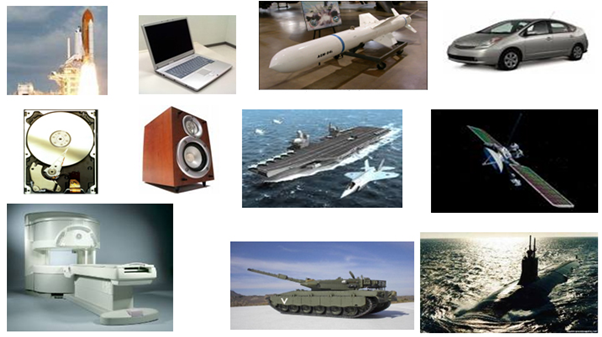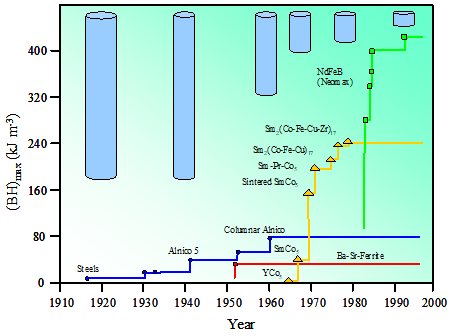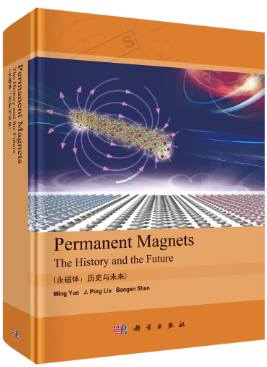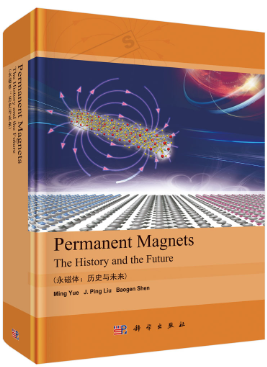博文
永磁体:历史与未来
|
正因如此,永磁材料已经成为现代社会不可或缺的一类重要的基础功能材料,广泛的应用于航空、航天、核能工业等高技术领域,以及仪器仪表、医疗装备、信息的存储和传输等日常生活中(图1)。

图1 永磁材料应用的部分领域
人类对永磁材料的认知和使用始于两千多年前的天然磁石(永磁铁氧体),其主要的用途是制作指南针。而人造永磁材料出现和工业化生产仅有百余年的历史。以磁性能高低(即磁能积大小)作为标准,先后出现了碳钢、铝镍钴、铁氧体、稀土永磁等几大类永磁材料(图2)。其中,号称“磁王”的烧结钕铁硼永磁于上世纪八十年代诞生,其磁性能于本世纪接近了理论值。

图2 人造永磁材料的百年发展历程(以磁能积大小为标准)
近年来,随着电动汽车、风能发电等绿色能源技术的迅猛发展,对于永磁材料的能量密度和工作稳定性提出了更高的要求。因此,关于永磁材料高性能化的研究,包括具有更高磁性能的新一代永磁材料的设计开发和现有各类永磁材料使役性能(包括磁性能、温度稳定性和化学稳定性等)的升级,日益受到广泛关注并取得了较好进展。与此同时,相关的理论研究也随之得到发展。遗憾的是,近年来国际上关于新型永磁材料及其理论研究进展的系统性报道较少。针对这种情况,《永磁体:历史与未来》(Permanent Magnets: The History and the Future)致力于报道先进永磁材料的最新研究进展。内容涵盖了从基础理论到应用技术,从现行磁体的优化到新型磁体的研发的多个方面。书中的主题包括永磁材料的技术磁化理论、多种先进永磁材料的发展以及永磁材料的制备和再利用技术。

全书共分十章,具体包括五个部分:第一部分包括第1章,回顾了永磁材料的发展历史,展望了其未来的发展方向。第二部分包括第2章,介绍了永磁材料矫顽力机理的理论研究。第三部分包括第3章到第6章,内容涉及几种先进永磁材料的发展,具体包括钐钴永磁材料、ThMn12型R-Fe-M永磁材料、Mn基永磁材料及纳米复合永磁材料。第四部分包括第7章到第9章,介绍了稀土永磁材料的制备和调控技术。第五部分包括第10章,介绍了稀土永磁材料二次资源的再生技术。
岳明,北京工业大学教授,博士生导师。2001年毕业于北京科技大学,获得工学博士学位,2007~2008年在美国得克萨斯大学阿灵顿分校做访问学者。学术兼职包括国际稀土永磁专业委员会委员、中国稀土学会理事、稀土永磁材料国家重点实验室副主任等。从事稀土永磁材料高性能化、稀土二次资源的绿色再生的应用基础研究与工业化转化。率先开展了我国具有自主知识产权的稀土永磁二次资源的绿色再生及产业化研究。发表学术论文200余篇,获授权中国发明专利60余项,国际发明专利3项。制定国家标准1项。曾获教育部技术发明一等奖(2019)、安徽省科学技术奖一等奖(2016)及教育部技术发明二等奖(2014)。 沈保根,中国科学院物理研究所研究员、博士生导师,中国科学院院士,发展中国家科学院院士,第十二届全国政协委员。1976年毕业于中国科学技术大学物理系。曾任中国科学院物理研究所党委书记、磁学国家重点实验室主任,中国科学院副秘书长兼学部主席团秘书长、院士工作局局长,中国电子学会应用磁学分会主任,中国物理学会磁学专业委员会主任等。现任中国科学院稀土研究院首席科学家,中国科学院大学教授,中国散裂中子源科技委主任,合肥稳态强磁场装置科技委主任,中国高技术产业化研究会副理事长,《中国大百科全书》物理学科副主编,《Chinese Physics B》、《物理学报》副主编等。长期从事磁学和磁性材料的研究工作,发表学术论文600余篇,获国家发明专利50多件。培养博士研究生50余名。国家杰出青年科学基金获得者,国家973项目首席科学家,获香港求是科技基金会“杰出青年学者奖”,中国物理学会叶企孙物理奖,北京市科技进步奖一等奖、国家自然科学奖二等奖、何梁何利科学与技术进步奖、陈嘉庚技术科学奖等。

书号:9787030644381
作者:岳明, (美)刘平, 沈保根
内容简介 《永磁体:历史与未来》致力于提供永磁体在理论和实验研究方面的前沿进展。它涵盖了宽广的范围:从基本理论到先进技术,从传统磁体改进到新型磁体研发,从磁体的制造到回收利用。本书的主要内容包括:永磁体的矫顽力理论,各种先进永磁体的发展历程,以及磁体的制造和回收技术等。 本书是“强磁场下的基础科学问题学科发展战略研究咨询项目”(沈保根院士负责)成果的汇集,各章作者均为在永磁基础研究领域一线优秀科研人员,讨论的内容为当前国际相关领域的前沿。为便于国际交流,本书全部为英文写作。
Contents
Preface
Chapter 1 Millenniums of Permanent Magnets: From Compasses to Rare-earth Magnets 1
References 5
Chapter 2 Coercivity Mechanisms in Nanostructured Permanent Magnets 7
2.1 Introduction 8
2.2 Hysteresis loops and a survey of various coercivity mechanisms 10
2.2.1 Hysteresis loops 10
2.2.2 Coherent rotation and domain wall motion 12
2.2.3 Various modes of nucleation and nucleation expansion 14
2.2.4 Numerical approaches and more advanced models 16
2.3 Interface-pinning of well-oriented permanent magnetic systems 18
2.3.1 Basic formulation 18
2.3.2 Comparison of nucleation and self-pinning fields 19
2.3.3 Experimental evidence and comparison with other theories 25
2.4 Discussions and conclusions 26
2.4.1 Single-phase versus two-phases 26
2.4.2 Pinning versus nucleation 27
2.4.3 Size e.ect and grain boundary enhancement 29
2.4.4 Conclusions 30
References 31
Chapter 3 Sm-Co High-Temperature Permanent Magnet Materials 36
3.1 Introduction 36
3.2 Historical review of development of Sm-Co permanent magnets 38
3.3 Phase diagram and crystal structures 40
3.4 Intrinsic magnetic properties of R-Co compounds 42
3.5 Sm-Co permanent magnets capable of operating up to 300 46
3.6 High-temperature Sm2(Co, Fe, Cu, Zr)17-type magnets capable of operating up to 550 51
3.6.1 Effects of compositions on high-temperature intrinsic coercivity of Sm-TM permanent magnets 52
3.6.2 New high-temperature Sm2(Co, Fe, Cu, Zr)17-type magnets 53
3.6.3 Long-term thermal stability of new high-temperature permanent magnets 56
3.6.4 Abnormal temperature dependence of intrinsic coercivity 57
3.7 Thermal stability, temperature coeffcient, and modeling of temperature-compensated magnets 57
3.7.1 Reversible and irreversible flux density loss 57
3.7.2 Temperature coeffcient 59
3.7.3 Modeling of temperature-compensated magnets 62
3.8 Nanograin structure, nanocrystalline, and nanocomposite Sm-Co magnetic materials 65
3.9 Other Sm-Co permanent magnet materials 72
3.10 Prospects of future rare earth permanent magnet materials 73
3.11 Conclusions 76
References 77
Chapter 4 Ternary Fe-rich R-Fe-M Intermetallics with the ThMn12-type Structure and Their Interstitial Compounds 82
4.1 Introduction 82
4.2 Part one: Ternary Fe rich 1-12 compounds 85
4.2.1 Structural and magnetic properties of Y(Mn1.xFex)12 which is the first synthesis of Fe-rich 1-12 compounds 85
4.2.2 Structural and magnetic properties of RFe12.xMx 90
4.2.3 Structural and magnetic properties of RTiFe11 in comparison with RTiCo11 and YTi(Fe1.xNix)11 90
4.3 Part two: Interstitial nitrogen atom e.ect on the 1-12 compounds and its applications 108
4.3.1 Interstitial nitrogen atom e.ect on the 1-12 compounds 108
4.3.2 Interstitial hydrogen (or carbon) atom e.ect on the 1-12 compounds 116
4.3.3 Development of novel permanent magnets based on R(Fe,M)12Nx 121
4.4 Concluding remarks 129
References 130
Chapter 5 Mn-based Permanent Magnets 134
5.1 Introduction 135
5.2 Mn-Al hard magnetic phase 136
5.3 MnBi hard magnetic materials 147
5.4 MnxGa magnetic materials 157
5.5 Summary 164
References 164
Chapter 6 Anisotropic Nanocomposite Soft/Hard Multilayer Magnets 169
6.1 Introduction 170
6.2 The anisotropic Nd2Fe14B based nanocomposite multilayer magnets 171
6.3 Anisotropic SmCo5 based nanocomposite permanent multilayer magnets 204
6.4 Anisotropic rare-earth free based nanocomposite permanent multilayer magnets 211
References 218
Chapter 7 Nanocrystalline and Nanocomposite Permanent Magnets by Melt Spinning Technique 223
7.1 Melt-spinning technique 224
7.2 Uniqueness in melt-spun materials 227
7.2.1 Cooling control 229
7.2.2 Amorphization and crystallization 232
7.2.3 Phase formation 234
7.2.4 Consolidation 236
7.3 Melt-spun materials 241
7.3.1 Single-phase nanocrystalline magnets 241
7.3.2 Nanocomposite magnets 266
7.3.3 Precipitation-hardening ribbons 288
7.4 Magnetic phenomena in melt-spun magnets 300
7.4.1 Single-phase magnetic behavior 301
7.4.2 Remanence enhancement 303
7.4.3 Henkel plot 306
7.4.4 Recoil loop 311
7.4.5 First-order reversal curve 317
7.4.6 Coercivity and microstructure parameters 320
7.4.7 Reversible and irreversible magnetization 323
7.5 Summary and outlook 325
References 326
Chapter 8 Grain Boundary Restructuring and La/Ce/Y Application in Nd-Fe-B Magnets 339
8.1 Introduction 340
8.2 Grain boundary restructuring of Nd-Fe-B sintered magnets 341
8.2.1 Fundamentals of grain boundary restructuring 341
8.2.2 (Pr, Nd)32:5Fe62:0Cu5:5 restructuring: High corrosion-resistant Nd-Fe-B 342
8.2.3 Dy71:5Fe28:5 restructuring: High-coercivity Nd-Fe-B 350
8.3 Application of high-abundant La/Y/Ce in Nd-Fe-B magnets 355
8.3.1 La-Ce co-substitution 356
8.3.2 Y-Ce co-substitution for Nd 381
8.3.3 Effect of REFe2 on microstructure and magnetic properties of (Nd, Ce)-Fe-B sintered magnets 387
8.4 Summary and perspectives 398
References 399
Chapter 9 Rare Earth Permanent Magnets Prepared by Hot Deformation Process 404
9.1 Introduction 405
9.2 Effect of preparation parameters on HD magnets 407
9.2.1 HP temperature 408
9.2.2 HD temperature 409
9.2.3 Deformation degree 410
9.2.4 Strain rate 412
9.2.5 Inhomogeneity of microstructure in HD magnet 413
9.2.6 Influence of chemical composition 414
9.3 Coercivity enhancement for HD Nd-Fe-B magnets 417
9.3.1 Coercivity mechanism of HD Nd-Fe-B magnets 417
9.3.2 Coercivity enhancement of hot-deformed Nd-Fe-B magnets 418
9.3.3 Discussion on the coercivity enhancement of HD Nd-Fe-B magnets 423
9.4 HD nanocomposite Nd-Fe-B magnets 425
9.4.1 Nanocomposite magnets prepared by Nd-lean powders 426
9.4.2 Nanocomposite magnets prepared by the co-doping technique 429
9.4.3 The deformability enhancement of nanocomposite magnets by introducing rare-earth-rich liquid phase 430
9.5 Radially oriented Nd-Fe-B ring magnet prepared by backward extrusion method 432
9.5.1 Texture evolution in backward extrusion of NdFeB ring magnet 434
9.5.2 Magnetic performance improvement of backward-extruded NdFeB RM 436
9.5.3 Solution for tangential crack in NdFeB RM 437
9.6 Physical properties of HD Nd-Fe-B magnets 440
9.6.1 Mechanical properties of HD Nd-Fe-B magnet 440
9.6.2 Electrical properties of HD Nd-Fe-B magnet 443
References 445
Chapter 10 Progress in Recycling of Nd-Fe-B Sintered Magnet Wastes 451
10.1 Introduction 452
10.2 Recycling techniques for bulk Nd-Fe-B sintered magnet wastes 454
10.2.1 Introduction to the recycling techniques 454
10.2.2 Magnet-magnet techniques 455
10.2.3 Magnet-powder technologies 460
10.3 Overall properties of the recycled Nd-Fe-B sintered magnets 464
10.3.1 Thermal stability of the recycled magnets 464
10.3.2 Chemical stability of the recycled magnets 465
10.3.3 Mechanical properties of the recycled magnets 468
10.4 Recycling of bulk Nd-Fe-B sintered wastes at mass production level 468
10.5 Concluding remarks and perspectives 471
References 472
(本文编辑:王芳)

一起阅读科学!
科学出版社│微信ID:sciencepress-cspm
专业品质 学术价值
原创好读 科学品味
https://wap.sciencenet.cn/blog-528739-1241859.html
上一篇:张会刚:电化学储能材料与原理
下一篇:我国发展基因组编辑技术的建议丨中科院颠覆性技术创新研究